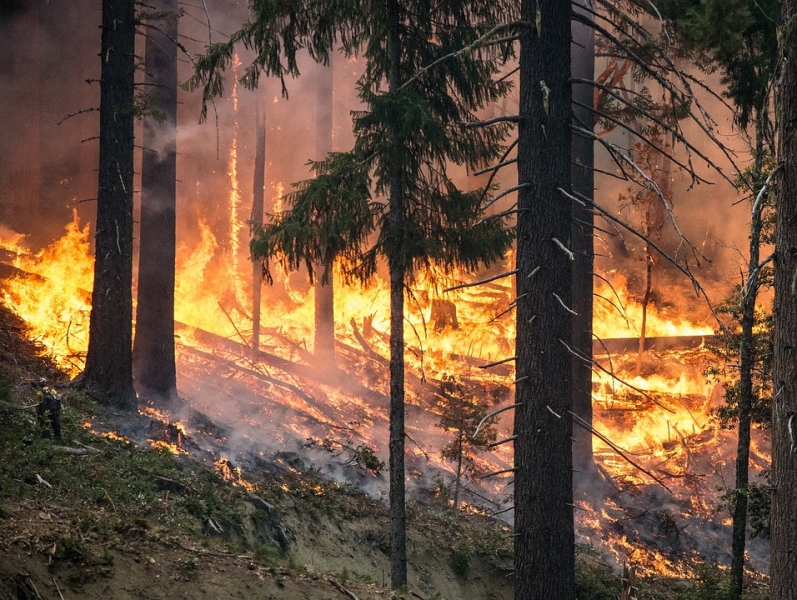The 2018 wildfire season in California has been the state’s deadliest on record, and the 10 most deadly fires in California’s history occurred in the last four years. In a deviation from historic records, documentation of these recent fires show that their occurrence has become nearly year-round rather than seasonal. These fires pose extreme threats to 25 million acres of California’s wildlands, as well as to the 11 million people who live within the threatened area. In addition to intensifying climate change, faulty equipment and electric transmission from utility companies have contributed to the increase in wildfires in these high-risk regions. However, taking full monetary responsibility for these fires can lead to near or certain bankruptcy for the utility companies.
 In February 2019, California Gov. Gavin Newsom convened a new strike force to develop crucial strategies to mitigate the loss of lives, property, energy reliability, and other forms of destabilization that these fires inevitably cause. In April, the strike force issued its highly anticipated report, Wildfires and Climate Change: California’s Energy Futures. The focus of the report is on mitigation and resilience, and includes methods such as expanding fire prevention through increased forest management and new fire prevention and prediction technology. The strike force also encourages community resilience through increased evacuation preparedness, better land use practices, and affordable home fortification. Additionally, it makes improved fire suppression and response efforts a clear priority and recommends increasing the number of firefighting aircrafts, increasing the number of fire engines, and redeploying the National Guard from the border in the case of a wildfire. In conjunction, the report recommends a statewide shift to clean energy to streamline a fragmented energy grid and overall energy standards to increase transparency and planning efforts for energy providers. The report further requests amplified aid from the government in order to help manage the federal forestland within California. Considering 57% of the forestland in California is federal land, this request may have a considerable impact on helping manage forestland and preventing wildfires.
In February 2019, California Gov. Gavin Newsom convened a new strike force to develop crucial strategies to mitigate the loss of lives, property, energy reliability, and other forms of destabilization that these fires inevitably cause. In April, the strike force issued its highly anticipated report, Wildfires and Climate Change: California’s Energy Futures. The focus of the report is on mitigation and resilience, and includes methods such as expanding fire prevention through increased forest management and new fire prevention and prediction technology. The strike force also encourages community resilience through increased evacuation preparedness, better land use practices, and affordable home fortification. Additionally, it makes improved fire suppression and response efforts a clear priority and recommends increasing the number of firefighting aircrafts, increasing the number of fire engines, and redeploying the National Guard from the border in the case of a wildfire. In conjunction, the report recommends a statewide shift to clean energy to streamline a fragmented energy grid and overall energy standards to increase transparency and planning efforts for energy providers. The report further requests amplified aid from the government in order to help manage the federal forestland within California. Considering 57% of the forestland in California is federal land, this request may have a considerable impact on helping manage forestland and preventing wildfires.
From a regulatory standpoint, this report focuses on the importance of responsibility, but it acknowledges that putting full responsibility on the utility companies would be unsustainable moving forward for both fire victims and those who rely on affordable power. It suggests that when a utility does not fulfill its role safely, utility shareholders should be responsible. In all other cases, however, the report acknowledges the need for a plan that shares the responsibility widely among stakeholders including insurance companies, local governments, and the utility ratepayers and investors. The report identifies key principles for allocating wildfire cost responsibilities, including increasing safe and affordable power, following California’s clean energy goals, and treating wildfire victims fairly. It sets forth three facets for achieving these principles. The first facet is a liquidity fund that would allow utilities to pay damage funds more quickly than before. Secondly, the report recommends modifying the current liability standard to a fault-based one to reduce the burden on utilities when they are not directly at fault. The final facet is the creation of a wildfire fund to share the cost posed by wildfires among stakeholders and to serve as a monetary safety net in times of crisis.
The California Commission on Catastrophic Wildfire Cost and Recovery is building upon the Strike Force report and will publish its set of recommendations to Governor Newsom and the California Legislature on July 1. But a number of questions around the viability of the report’s solutions remain, ranging from how much the California government will adhere to the report moving forward, to the willingness of the federal government to support California’s efforts, to whether these proposed changes can be implemented quickly enough to protect California from the present threat of increasingly damaging wildfires.
The Environmental Law Institute, Nossaman LLP, and leading experts in the field will be exploring these questions and more in an upcoming event on Wednesday, June 12, from 11:00 am to 12:30 pm PT at Nossaman LLP in Los Angeles. The panel will cover key topics such as wildfire liability, the viability of various wildfire mitigation strategies, cost recovery options, and incorporating climate resiliency into wildfire policymaking.
This event is open and free to the public, but please register by June 10. Event details and RSVP information can be found here.
